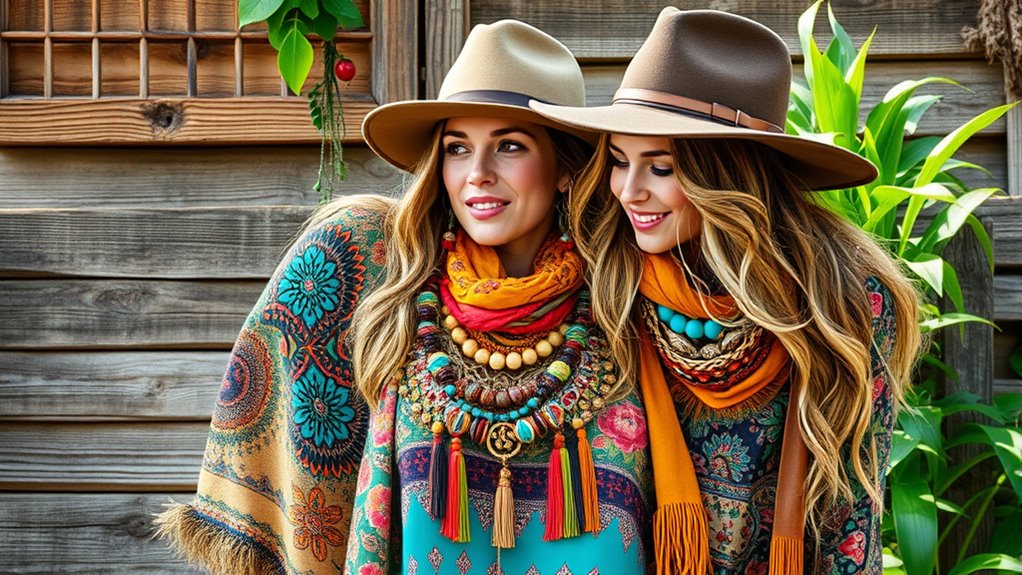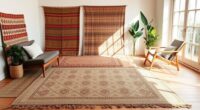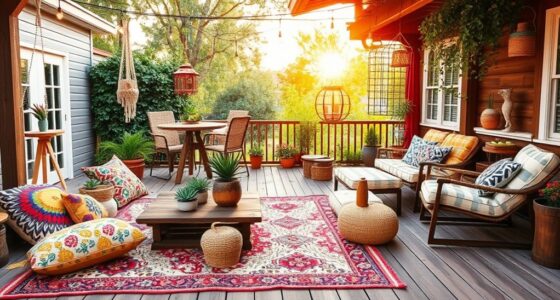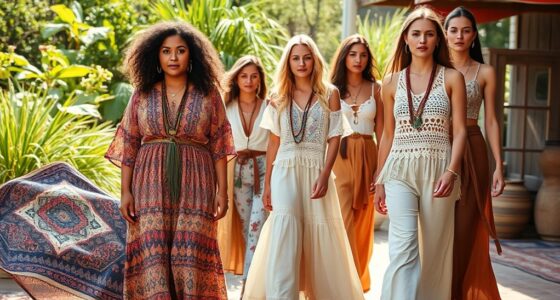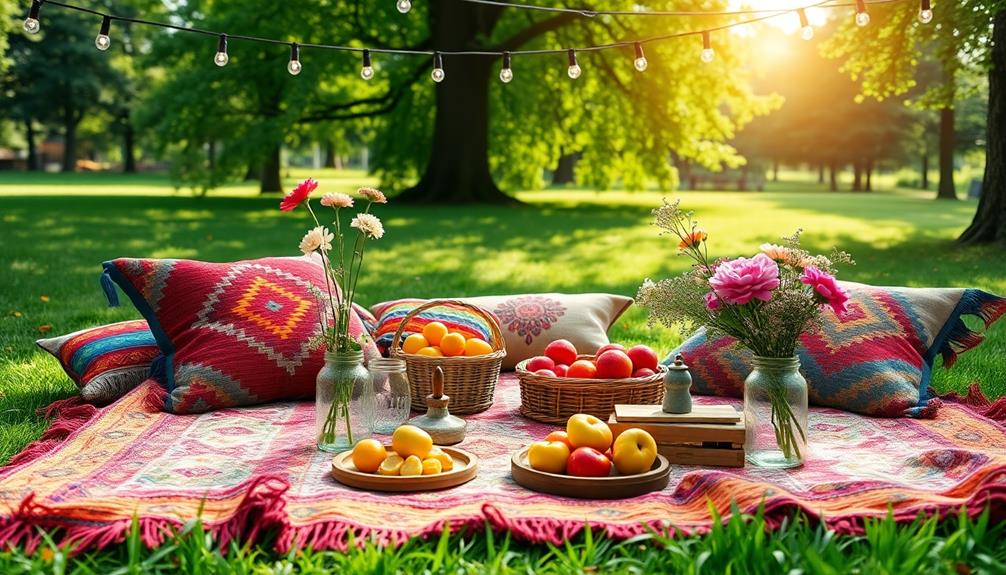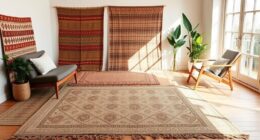The boho aesthetic started in 19th-century France as a rebellious style among artists, emphasizing individuality with loose, layered garments and vibrant patterns. Over time, it gained popularity through influential art movements, embracing ethnic influences and relaxed silhouettes. In the 1960s and 70s, it became linked to the hippie movement, highlighting peace and nature. Today, boho blends vintage, ethnic, and sustainable fashion, celebrating personal expression—keep exploring to see how it continues to evolve and inspire.
Key Takeaways
- Originated in 19th-century France as a rebellious, eclectic style among artists emphasizing individualism and artisanal influences.
- Gained popularity through artists like Rossetti and Renoir, promoting relaxed silhouettes and vintage, ethnic fabrics.
- Shifted toward practical, comfortable fashion in the 1880s with societal movements like the Rational Dress Society.
- Became associated with the 1960s-70s hippie movement, embracing nature, peace, and layered, earthy garments.
- Modern boho blends vintage, sustainable fashion with vibrant patterns, ethnic influences, and celebrates self-expression globally.
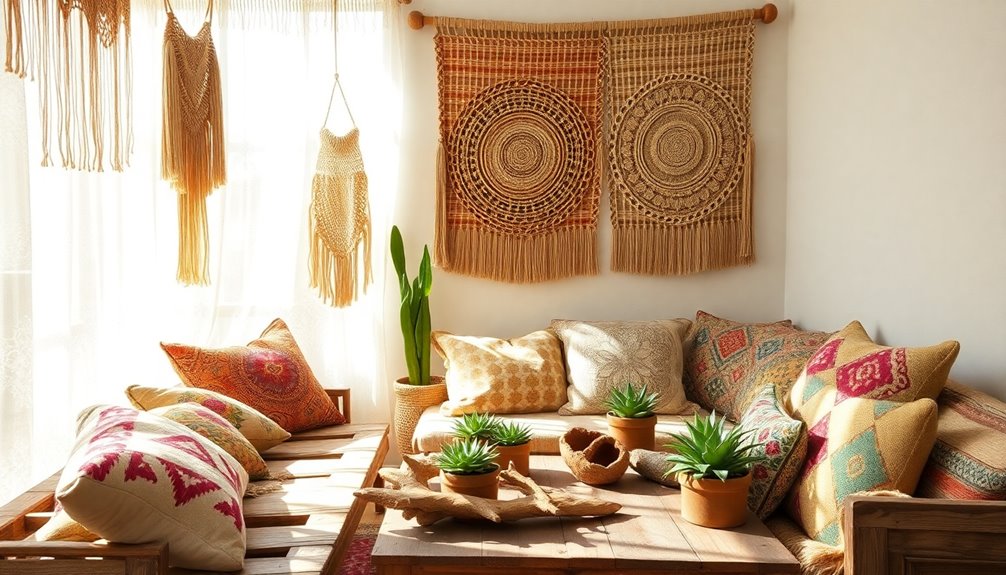
The boho aesthetic has a rich history that begins in 19th-century France, where it emerged as a counterculture among artists and writers. You can see its roots in ragged clothing and eclectic styles that reflected a rejection of mainstream fashion. These early bohemians prioritized individualism, often wearing loose-fitting garments inspired by medieval and artisanal influences. Their outfits featured vibrant patterns and layered textures, creating a look that was both artistic and free-spirited.
The boho style originated in 19th-century France as a rebellious, artistic expression of individualism and eclectic fashion.
This style wasn’t just about appearance; it represented a deeper desire for self-expression and a break from societal norms.
As the 19th century progressed, influential figures like Dante Gabriel Rossetti and Pierre-Auguste Renoir popularized bohemian fashion through their art. They emphasized relaxed silhouettes, mixing vintage fabrics with ethnic influences, which added to the aesthetic’s eclectic appeal.
The movement also gained practical momentum when the Rational Dress Society of the 1880s promoted loose-fitting, comfortable clothing. This push toward practicality helped shift boho style from solely artistic expression to something more wearable, emphasizing health-conscious fashion choices that still maintained a sense of individuality.
Moving into the 20th century, boho style evolved alongside broader cultural shifts. The hippie movement of the 1960s and 70s brought ethnic influences, embroidery, and layered, free-spirited garments into the spotlight.
You’d find people embracing relaxed silhouettes, flowing skirts, and earthy tones that reflected a connection to nature and a desire for peace and love. The boho aesthetic became a symbol of artistic counterculture, embodying a rejection of materialism and celebrating authenticity.
Festival culture further popularized this look, with music festivals becoming platforms to showcase these relaxed, vibrant styles.
In recent decades, especially from the 2000s onward, boho fashion has entered mainstream consciousness. Big-name celebrities and the rise of festival culture helped spread its influence globally.
Today, boho style combines vintage elements with modern, sustainable fashion practices. You’re likely to see garments featuring ethnic patterns, embroidery, and layered accessories, all crafted with an eye toward sustainability.
This enduring appeal is supported by the versatility of boho fashion, allowing individuals to express their unique identities in various settings. The aesthetic continues to celebrate individualism, relaxed silhouettes, and vibrant patterns, making it a versatile, enduring style that bridges art, culture, and activism.
Whether at a music festival or in everyday wear, boho remains a powerful expression of freedom, creativity, and respect for diverse influences.
Frequently Asked Questions
What Is the Origin of Boho Style?
You might wonder where boho style comes from. It started in 19th-century France among artists and intellectuals who wanted to express their individuality through loose, flowing clothing.
Influenced by medieval fashion, European artisans, and Romantic ideals, it challenged formal, restrictive styles of the upper class.
As a symbol of non-conformity and creativity, boho style reflects a rebellious, nomadic spirit rooted in artistic freedom.
What Is the History of Boho Art?
You’re asking about the history of boho art, which traces back to 19th-century Romanticism, emphasizing emotion and individualism. Artists like Dante Gabriel Rossetti drew inspiration from medieval and Renaissance art, using vibrant colors and intricate details.
The movement also channels the Aesthetic Movement’s focus on beauty and craftsmanship, while Impressionists contributed with luminous landscapes and scenes of leisure, reflecting the bohemian lifestyle and cultural fusion that define boho art.
What Era Is Boho From?
You might wonder what era boho originates from. It actually started in France after the French Revolution in the late 18th and early 19th centuries.
The style gained popularity through Romanticism in the mid-1800s, influenced by artists like Renoir.
It then revived during the 1960s and 70s with hippie culture, blending historical and modern trends.
What Is Boho Aesthetic?
You’re curious about the boho aesthetic, which is all about flowing fabrics, vibrant patterns, and a mix of cultural influences.
It emphasizes comfort, creativity, and individual expression through layered clothing, crochet, lace, fringe, and vintage accessories.
This style reflects a free-spirited, artistic vibe, often inspired by global traditions and history.
It’s a look that celebrates uniqueness and a laid-back, eclectic vibe.
Conclusion
As you’ve seen, the boho aesthetic has journeyed through time, weaving together freedom, creativity, and individuality. It’s like a river that flows and adapts, yet never loses its spirit. So, as you embrace this style today, remember it’s more than just fashion—it’s a reflection of your soul’s wanderlust. Keep your spirit wild and your style true, for the boho journey is as endless as your imagination.

